S-4 interior photos: Difference between revisions
Pbcjohnston (talk | contribs) (Created S-4 interior page) |
Pbcjohnston (talk | contribs) (→Motor Room: Updated text based on blueprints) |
||
| (7 intermediate revisions by the same user not shown) | |||
| Line 3: | Line 3: | ||
=== Torpedo Room === | === Torpedo Room === | ||
[[File:S-4 torp 1.jpg|left|500px]] | |||
<div style="text-align: justify;"><span style="color:#00008B">Torpedo room looking forward. The detail of the overhead track for the chain hoists can be seen. There is a fore and aft track that leads to the port and starboard torpedo tubes. There is also a semicircular track that allows the transfer of torpedoes from side to side. The track is "gated" and can be swung into position for the use of the center track. | |||
The large vertical tanks on each side store high pressure air for impulse firing of the torpedoes out of the tubes. The bracing sticking out from the hull on each side provided storage for up to ten torpedoes for reloads. The submarine carried a total of fourteen torpedoes. Four of them were in the tubes and ten in the room. Two each on each of the lower wider brackets and one each on the top shorter bracket. | |||
<small>U.S. Navy photo.</small> | |||
[[File:Red bar sub new.jpg]] | |||
[[File:S-4 torp 2.jpg|left|500px]] | |||
<div style="text-align: justify;"><span style="color:#00008B">Torpedo room showing the forward port corner of the room and the port bank of torpedo tubes with their impulse tank. Associated piping is seen leaving the lower part of the tank and shows the cross over for the upper and lower tubes and the high pressure air piping at the top of the tank. | |||
Note that the numbers 2 and 4 are on the torpedo tube doors. That means these are tubes # 2 and #4 . Tubes 1 and 3 are the starboard bank of tubes seen on the extreme right of the photo. | |||
<small>U.S. Navy photo.</small> | |||
[[File:Red bar sub new.jpg]] | |||
[[File:S-4 torp 3.jpg|left|500px]] | |||
<div style="text-align: justify;"><span style="color:#00008B">Torpedo room looking aft. The detail of the overhead track for the chain hoists can be seen. There is a fore and aft track that leads to the port and starboard torpedo tubes. There is also a semicircular track that allows the transfer of torpedoes from side to side. The track is "gated" and can be swung into position for the use of the center track. | |||
This view shows the torpedo storage racks more clearly. The submarine carried a total of fourteen torpedoes. Four of them were in the tubes and ten in the room. Two each on each of the lower wider brackets and one each on the top shorter bracket. Bunks can be seen tilted up in the after end of the room The torpedo loading skid can be seen on the top brace on the right side of the photo. Looking through the door into the battery/berthing compartment you can see crews berthing with the bunks "triced up". | |||
<small>U.S. Navy photo.</small> | |||
[[File:Red bar sub new.jpg]] | |||
[[File:S-4 torp 4.jpg|left|500px]] | |||
<div style="text-align: justify;"><span style="color:#00008B">The aft port corner of the torpedo room. A few interesting things here. The large circular object above the large piping is the back side of a Fessenden Oscillator, an early underwater listening and communication device. There appears to be two electric space heaters fitted between the frames just forward of the Fessenden Oscillator. The piping is for the trim and drain system and fuel oil transfer system. | |||
<small>U.S. Navy photo.</small> | |||
[[File:Red bar sub new.jpg]] | |||
<div style="text-align: justify;"><span style="color:#000000"> | |||
=== Battery Compartment/Berthing === | === Battery Compartment/Berthing === | ||
</div> | |||
[[File:S-4 batt 1.jpg|left|500px]] | |||
<div style="text-align: justify;"><span style="color:#00008B">S-4 Battery Compartment/Berthing area gives a good perspective of the compartment. The view is looking aft toward the officers berthing and the Control Room. There appears to be several tables folded up on the bulkhead at the end of the compartment. | |||
The bunks are triced up and have bedding on them, so this is an actively used compartment. In later years a cover was developed that contained the mattress and bedding and helped protect these combustible materials from burning in case of a flash fire. It is called a "flash cover" but they are missing from this image. | |||
You can see the support cables and turnbuckles used to stabilize the bunk stanchions. They were suspended from the overhead since nothing was attached to the battery cover. If you look carefully, you can see the Christmas Bell hanging forward of the top far bunk and in line with the left door frame. | |||
<small>U.S. Navy photo.</small> | |||
[[File:Red bar sub new.jpg]] | |||
[[File:S-4 batt 2.jpg|left|500px]] | |||
<div style="text-align: justify;"><span style="color:#00008B"> Battery compartment and berthing, the view is looking forward toward the torpedo room. Note the fancy tissue paper Christmas Bell hanging from the overhead. Photo was taken on Christmas Day 1919. The bunks are "triced up", meaning they are tipped up and out of the way for ease of movement through the vessel and for cleaning. The bunks are either attached to the hull and supported by chains or, in the case of the center tiers of bunks, supported by the stanchion from the overhead. There are 36 bunks in this compartment, three banks of 12, four per row and three high. Personal lockers are seen on either side of the compartment. | |||
Nothing was attached to the deck since it was the cover for the battery. It consisted of removable planking covered with painted and shellacked canvas for waterproofing. Even though it looks like the heater is attached to the deck that is just a wooden pad to protect the canvas from the metal legs. The heater is portable not attached to the bunk stanchion. You can see the power cord snaking up to the overhead and down to a plug on the right. The bunks are all are braced by cables from the overhead to the foot of the stanchion to prevent sideways movement. A second space heater can be seen at the far end of the compartment and it looks to be bulkhead mounted. | |||
The battery was made by Gould and was a Model 35-U. It was divided into two sections of 60 cells each. The total battery had a capacity of 1240 KWH. Just forward of the space heater you can see a light colored line going across the compartment. This is the divider bulkhead between the forward and aft sections of the battery. | |||
The crew slept and ate in this compartment. The table to the left is just one of six fold up tables used for eating. When not in use they were folded up and stored at the aft end of the compartment. (see next photo) The chairs were for seating at the table as well as relaxing in. The rectangular ventilation duct work can be seen running a long the left side of the photo. | |||
I'm told that the crews only head (toilet) was at the forward end of this compartment and was used by officers and enlisted alike. | |||
<small>U.S. Navy photo.</small> | |||
[[File:Red bar sub new.jpg]] | |||
[[File:S-4 batt 3.jpg|left|500px]] | |||
<div style="text-align: justify;"><span style="color:#00008B">Four members of the S-4 crew are seen in this photo taken by one of the crew members. The men are not identified at this point. The view in this photo is almost identical to the photo seen above. The photo is undated, but the chances are good that the men seen in this photo perished when the submarine was rammed and sank in 1927. | |||
This photo was printed in a contemporary newspaper and identified as taken by former members of the crew. | |||
<small>Newspaper photo in the public domain.</small> | |||
[[File:Red bar sub new.jpg]] | |||
[[File:S-4 batt 4.jpg|left|500px]] | |||
<div style="text-align: justify;"><span style="color:#00008B">Same image as above but from an original photo and it hasn't been cropped for the newspapers. That cropping took the man, out of focus on the right, out of the photo. The men are not identified at this point. The view in this photo is almost identical to the photo seen above. The photo is undated, but the chances are good that the men seen in this photo perished when the submarine was rammed and sank. | |||
Flash from contributor's camera is seen at the top of the image. He did not want to be identified. | |||
<small>Photo from anonymous contributor in the private collection of Ric Hedman.</small> | |||
[[File:Red bar sub new.jpg]] | |||
[[File:S-4 batt 5.jpg|left|500px]] | |||
<div style="text-align: justify;"><span style="color:#00008B">Battery Compartment, with the view looking aft toward the officer's berthing and the control room. Again, note the fancy tissue paper Christmas Bell hanging from the overhead. Photo was taken on Christmas Day 1919. There appears to be three tables folded up on the left side of the passageway and two on the right. Officer's bunks were in the two staterooms on either side of the passageway to the control room. Assuming one for the Captain's stateroom, the other officers must have bunked together in the other one. | |||
The ever-ready urn of coffee, life blood of the Navy, sits on the counter. A tiny Christmas tree sits on the counter next to it. The battery compartment ventilation fan is on the right side of the photo. | |||
<small>U.S. Navy photo.</small> | |||
[[File:Red bar sub new.jpg]] | |||
<div style="text-align: justify;"><span style="color:#000000"> | |||
=== Control Room === | === Control Room === | ||
</div> | |||
[[File:S-4 cont 1.jpg|left|500px]] | |||
<div style="text-align: justify;"><span style="color:#00008B">S-4's chart table and compass binnacle located in the forward starboard corner of the control room. The drawers held charts and other navigation gear such as the parallel rulers, dividers, and probably the Navigator's sextant. | |||
<small>U.S. Navy photo.</small> | |||
[[File:Red bar sub new.jpg]] | |||
[[File:S-4 cont 2.jpg|left|500px]] | |||
<div style="text-align: justify;"><span style="color:#00008B">The control room looking forward to the battery compartment. The compass binnacle can be seen forward of the electrical panels on the right. Next to that is the chart table used for navigation. In the center of the room is the periscope in its lowered position. On the left are the bow and stern planes control wheels. The air manifold is on the forward bulkhead. Steering was performed in the tiny conning tower using electrical switches that sent signals to move the rudder left or right, or from the bridge while on the surface, using a control box on a long cable passed up from the conning tower. There was no actual helm wheel on these boats. | |||
The electrical panels on the right are part of what later would be moved aft to an area known as the "maneuvering room". The electrical power to the motors was controlled from here. It wascalso from here that the current from the generators put a charge back into the battery during a battery charge. The "Controllerman" or "DC Electrician" sat at his station on the seat provided and operated the "sticks" as needed to carry out the propulsion requirements of the submarine. | |||
The large motor in the center of the overhead is thought to be for raising and lowering the telescoping radio mast. The location is correct based on the observed drawings of this class of submarine. | |||
<small>U.S. Navy photo.</small> | |||
[[File:Red bar sub new.jpg]] | |||
[[File:S-4 cont 3.jpg|left|500px]] | |||
<div style="text-align: justify;"><span style="color:#00008B">The control room looking aft towards the engine room. The electrical panels on the left are part of what later would be moved aft to a compartment known as the maneuvering room. The electrical power for propulsion and the hotel load was routed to/from the battery to the main motors or from the generators. | |||
The two rooms with the corrugated sheet metal bulkheads are the radio room on the left and what most likely is the galley on the right. Through the door you can see the starboard diesel engine. The trim manifold is on the right side of the photo. The rheostat for controlling the trim pump is seen at the center of the photo edge. | |||
<small>U.S. Navy photo.</small> | |||
[[File:Red bar sub new.jpg]] | |||
[[File:S-4 cont 4.jpg|left|500px]] | |||
<div style="text-align: justify;"><span style="color:#00008B">The aft starboard corner of the control room. These are the handles to open and close the Kingston Valves or the main ballast tank vents. The Kingstons were located under the control room on the outside of the hull for admitting water to or from the ballast tanks. Speaking tubes can be seen just above them. One for talking aft the other for talking forward. The electrical panels on the left are part of the maneuvering area handling the electrical power to the motors or from the generators. | |||
The door to the radio room is open and a small portion of the radio and its associated equipment can be seen. You can see that the door is quite thick so the room is probably well sound insulated so the radioman would have no problems hearing the signals. | |||
<small>U.S. Navy photo.</small> | |||
[[File:Red bar sub new.jpg]] | |||
[[File:S-4 cont 5.jpg|left|500px]] | |||
<div style="text-align: justify;"><span style="color:#00008B">This photo is actually from the S-4's sister boat, the [[S-5|'''S-5''']]. It shows the opposite side of the control room, and the Kingston and vent levers for the port side ballast tanks. Vents let air escape from the ballast tanks so water can fill them to allow the sub to dive. Seen next to the Kingston levers is the trim manifold used for moving water around the sub for ballasting or pumping bilges. We do not know what the bottle looking device is unless it is to trap air caught in the pumping system. | |||
Seen on the bulkhead to the left is the drop-down serving window from the ship's galley. | |||
<small>U.S. Navy photo.</small> | |||
[[File:Red bar sub new.jpg]] | |||
<div style="text-align: justify;"><span style="color:#000000"> | |||
=== Engine Room === | === Engine Room === | ||
</div> | |||
[[File:S-4 eng 1.jpg|left|500px]] | |||
<div style="text-align: justify;"><span style="color:#00008B">The forward end of the engine room looking aft to the door to the motor room. The ladder to the engine room deck hatch can be seen in the foreground. It was movable and probably was stowed out of the way or maybe even folded up into the overhead to make passage through the boat easier. | |||
The two 700 HP NELSECO design MAN derivative 4-cycle diesel engines are seen filling the room either side of the center walkway. These engines were built from the NELSECO/MAN design at the Washington and Brooklyn Navy Yards. Although the Navy's experience with these engines was not perfect, they were at least better than the model installed in the EB design S-boats. | |||
<small>U.S. Navy photo.</small> | |||
[[File:Red bar sub new.jpg]] | |||
[[File:S-4 eng 2.jpg|left|500px]] | |||
<div style="text-align: justify;"><span style="color:#00008B">This photo is from the aft end of the engine room looking forward to the door to the control room. The external rocker arms for opening and closing the valves to admit fuel and air and expel exhaust can be seen clearly on the sides of these C&R built NELSECO/MAN diesels. Far from being a dark and dingy place the engine room is well lit and clean. | |||
<small>U.S. Navy photo.</small> | |||
[[File:Red bar sub new.jpg]] | |||
<div style="text-align: justify;"><span style="color:#000000"> | |||
=== Motor Room === | === Motor Room === | ||
</div> | |||
[[File:S-4 motor 1.jpg|left|500px]] | |||
<div style="text-align: justify;"><span style="color:#00008B">The motor room taken from the forward end looking aft toward the tiller room. This where the 600 horsepower Westinghouse main propulsion motors were located, directly below the photographer's feet under the walking deck. To the right you can see the Westinghouse logo on the main motor controller housing. Just past that on the right is the low-pressure ballast pump motor. At the far end of the room you can see the secondary steering station wheel. In an emergency, the boat could be steered from this location if the conning tower or control room were disabled. Just forward of the wheel on the right are louvered doors for a shower and a toilet (head). It was a bit unusual to have these facilities in this compartment, as there was no berthing here. Any crewman using the shower would have to pass through nearly the length of the boat from the berthing compartment to use it. The shower was eliminated in later Government-design boats, but the toilet remained, very useful to the engine room and motor room watchstanders. | |||
The ladder leads up to a deck hatch. In the overhead behind the ladder you can see the mechanical steering rod linkage heading aft to the tiller room. | |||
<small>U.S. Navy photo.</small> | |||
[[File:Red bar sub new.jpg]] | |||
[[File:S-4 motor 2.jpg|left|500px]] | |||
<div style="text-align: justify;"><span style="color:#00008B">The motor room taken from the aft end looking forward toward the engine room. The 600 horsepower Westinghouse main propulsion motors were underneath the raised walking deck in the background. To the right you can see a lathe and a vice. Repairs to equipment and machinery could be made using this work area and new parts could be fabricated by a skilled machinist. Forward of the lathe can be seen the high-pressure ballast pump and associated motor. On the right in the background against the hull is one of two main motor vent fans, used to keep the high powered motors from overheating. | |||
On the left the louvered doors for the shower and head can be seen. | |||
The silvery vertical stripe seen off to the left in the foreground is the back side of a sight glass probably showing the fluid level of the aft trim tank, In the photo above you can see it from the front. | |||
<small>U.S. Navy photo.</small> | |||
[[File:Red bar sub new.jpg]] | |||
<div style="text-align: justify;"><span style="color:#000000"> | <div style="text-align: justify;"><span style="color:#000000"> | ||
=== Tiller Room === | |||
</div> | |||
[[File:S-4 tiller room.jpg|left|500px]] | |||
<div style="text-align: justify;"><span style="color:#00008B">Photo taken in the motor room looking through the tiller room door. The tiller room was a separate watertight compartment housing the gearing for the rudder and stern planes. It was a very small compartment. Just beyond the open door you can see the large gears for the rudder post. To the left you can see a bench grinder, part of the machine shop of the submarine to do repairs underway. | |||
When the [[Notable Submarine Accidents|'''S-5 sank in 1920''']] due to a diving accident, the crew was able to blow the after ballast tanks and raise the stern of the boat above the waves. Only the last 17 feet or so of the stern was above water. The crew took turns entering the tiny tiller room to drill a series of holes in the outer hull using a barely operable and grounded electric drill. They then used a hand saw to connect the holes and cut away a portion of the outer hull just big enough to squeeze a man through. The crew was rescued by passing steamers. Given the size of this small compartment and the fact that the crew had to stand on the bulkhead due to the extreme angle of the boat, it is a miracle that the plan worked. | |||
<small>U.S. Navy photo.</small> | <small>U.S. Navy photo.</small> | ||
Latest revision as of 21:22, 2 March 2024
Torpedo Room
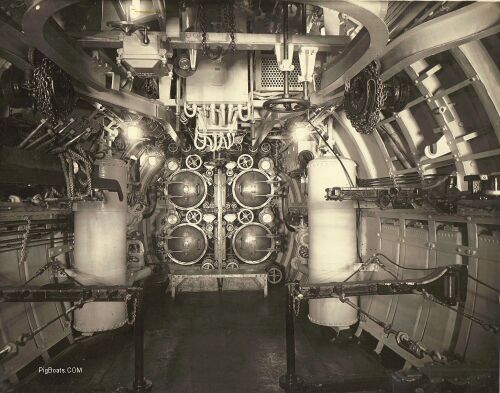
The large vertical tanks on each side store high pressure air for impulse firing of the torpedoes out of the tubes. The bracing sticking out from the hull on each side provided storage for up to ten torpedoes for reloads. The submarine carried a total of fourteen torpedoes. Four of them were in the tubes and ten in the room. Two each on each of the lower wider brackets and one each on the top shorter bracket.
U.S. Navy photo.
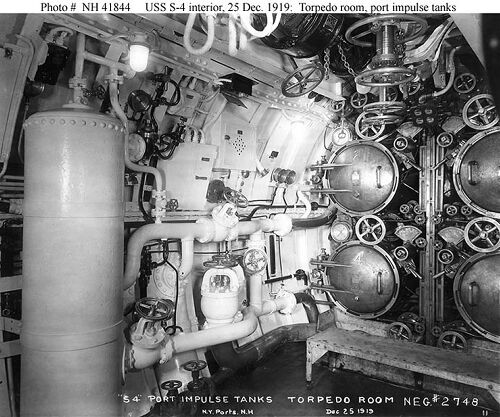
Note that the numbers 2 and 4 are on the torpedo tube doors. That means these are tubes # 2 and #4 . Tubes 1 and 3 are the starboard bank of tubes seen on the extreme right of the photo.
U.S. Navy photo.
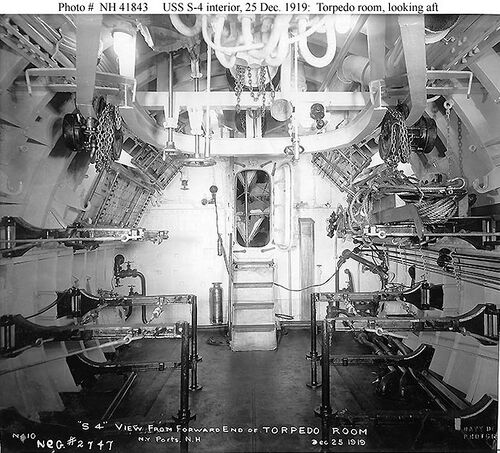
This view shows the torpedo storage racks more clearly. The submarine carried a total of fourteen torpedoes. Four of them were in the tubes and ten in the room. Two each on each of the lower wider brackets and one each on the top shorter bracket. Bunks can be seen tilted up in the after end of the room The torpedo loading skid can be seen on the top brace on the right side of the photo. Looking through the door into the battery/berthing compartment you can see crews berthing with the bunks "triced up".
U.S. Navy photo.

U.S. Navy photo.
Battery Compartment/Berthing
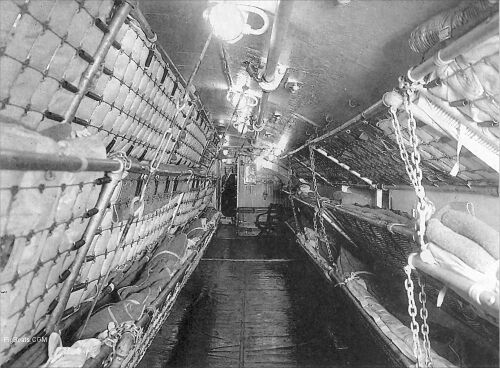
The bunks are triced up and have bedding on them, so this is an actively used compartment. In later years a cover was developed that contained the mattress and bedding and helped protect these combustible materials from burning in case of a flash fire. It is called a "flash cover" but they are missing from this image.
You can see the support cables and turnbuckles used to stabilize the bunk stanchions. They were suspended from the overhead since nothing was attached to the battery cover. If you look carefully, you can see the Christmas Bell hanging forward of the top far bunk and in line with the left door frame.
U.S. Navy photo.
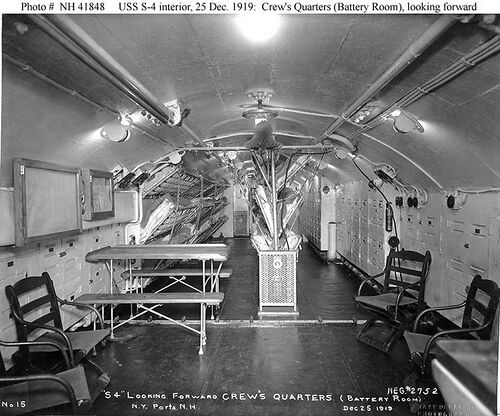
Nothing was attached to the deck since it was the cover for the battery. It consisted of removable planking covered with painted and shellacked canvas for waterproofing. Even though it looks like the heater is attached to the deck that is just a wooden pad to protect the canvas from the metal legs. The heater is portable not attached to the bunk stanchion. You can see the power cord snaking up to the overhead and down to a plug on the right. The bunks are all are braced by cables from the overhead to the foot of the stanchion to prevent sideways movement. A second space heater can be seen at the far end of the compartment and it looks to be bulkhead mounted.
The battery was made by Gould and was a Model 35-U. It was divided into two sections of 60 cells each. The total battery had a capacity of 1240 KWH. Just forward of the space heater you can see a light colored line going across the compartment. This is the divider bulkhead between the forward and aft sections of the battery.
The crew slept and ate in this compartment. The table to the left is just one of six fold up tables used for eating. When not in use they were folded up and stored at the aft end of the compartment. (see next photo) The chairs were for seating at the table as well as relaxing in. The rectangular ventilation duct work can be seen running a long the left side of the photo.
I'm told that the crews only head (toilet) was at the forward end of this compartment and was used by officers and enlisted alike.
U.S. Navy photo.
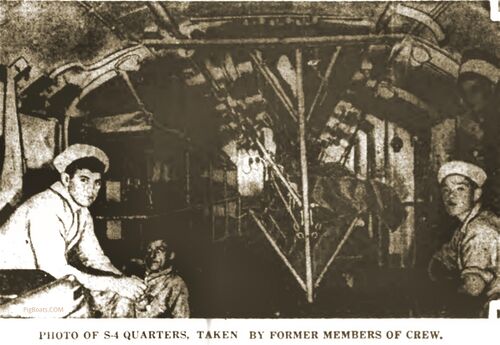
This photo was printed in a contemporary newspaper and identified as taken by former members of the crew.
Newspaper photo in the public domain.
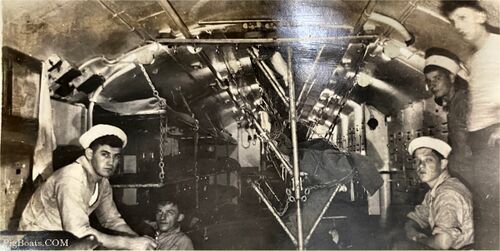
Flash from contributor's camera is seen at the top of the image. He did not want to be identified.
Photo from anonymous contributor in the private collection of Ric Hedman.
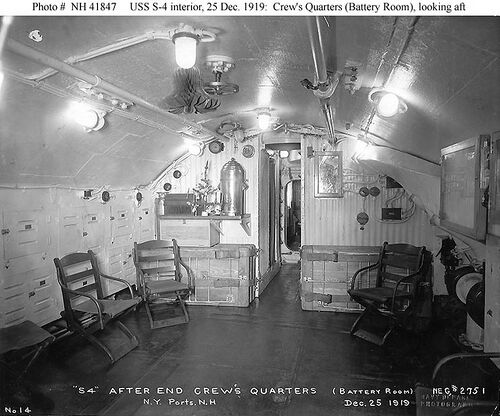
The ever-ready urn of coffee, life blood of the Navy, sits on the counter. A tiny Christmas tree sits on the counter next to it. The battery compartment ventilation fan is on the right side of the photo.
U.S. Navy photo.
Control Room
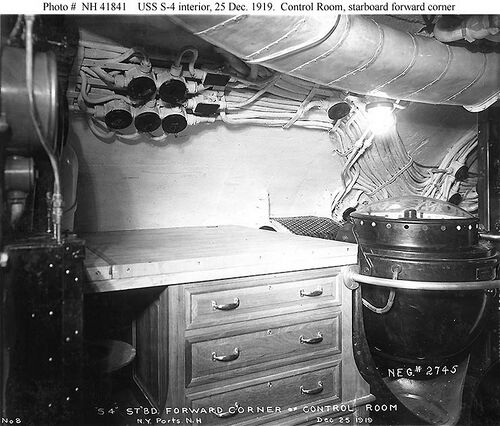
U.S. Navy photo.

The electrical panels on the right are part of what later would be moved aft to an area known as the "maneuvering room". The electrical power to the motors was controlled from here. It wascalso from here that the current from the generators put a charge back into the battery during a battery charge. The "Controllerman" or "DC Electrician" sat at his station on the seat provided and operated the "sticks" as needed to carry out the propulsion requirements of the submarine.
The large motor in the center of the overhead is thought to be for raising and lowering the telescoping radio mast. The location is correct based on the observed drawings of this class of submarine.
U.S. Navy photo.

The two rooms with the corrugated sheet metal bulkheads are the radio room on the left and what most likely is the galley on the right. Through the door you can see the starboard diesel engine. The trim manifold is on the right side of the photo. The rheostat for controlling the trim pump is seen at the center of the photo edge.
U.S. Navy photo.
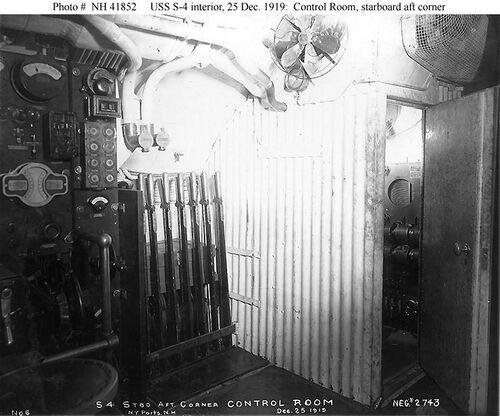
The door to the radio room is open and a small portion of the radio and its associated equipment can be seen. You can see that the door is quite thick so the room is probably well sound insulated so the radioman would have no problems hearing the signals.
U.S. Navy photo.
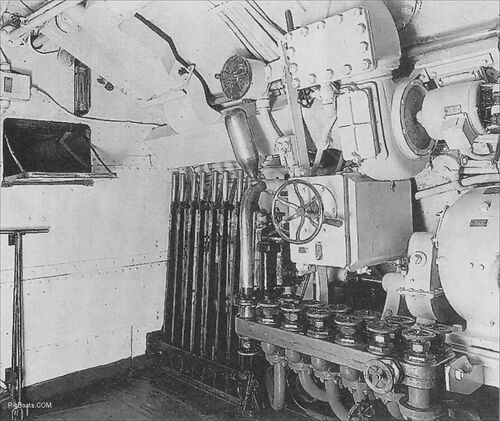
Seen on the bulkhead to the left is the drop-down serving window from the ship's galley.
U.S. Navy photo.
Engine Room

The two 700 HP NELSECO design MAN derivative 4-cycle diesel engines are seen filling the room either side of the center walkway. These engines were built from the NELSECO/MAN design at the Washington and Brooklyn Navy Yards. Although the Navy's experience with these engines was not perfect, they were at least better than the model installed in the EB design S-boats.
U.S. Navy photo.
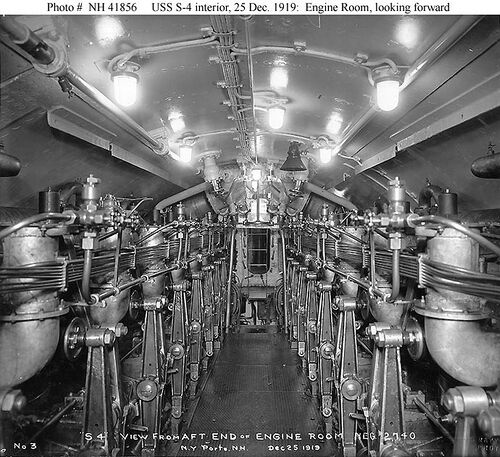
U.S. Navy photo.
Motor Room
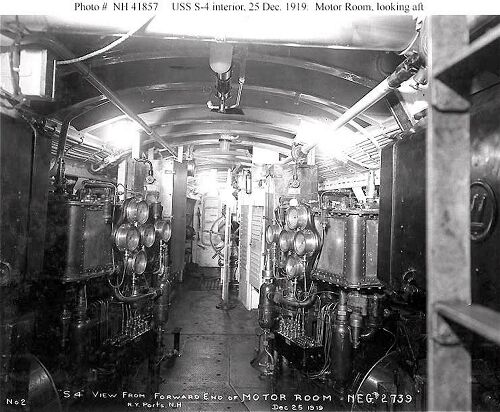
The ladder leads up to a deck hatch. In the overhead behind the ladder you can see the mechanical steering rod linkage heading aft to the tiller room.
U.S. Navy photo.
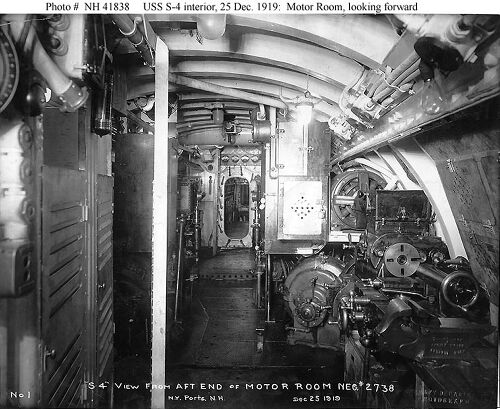
On the left the louvered doors for the shower and head can be seen.
The silvery vertical stripe seen off to the left in the foreground is the back side of a sight glass probably showing the fluid level of the aft trim tank, In the photo above you can see it from the front.
U.S. Navy photo.
Tiller Room

When the S-5 sank in 1920 due to a diving accident, the crew was able to blow the after ballast tanks and raise the stern of the boat above the waves. Only the last 17 feet or so of the stern was above water. The crew took turns entering the tiny tiller room to drill a series of holes in the outer hull using a barely operable and grounded electric drill. They then used a hand saw to connect the holes and cut away a portion of the outer hull just big enough to squeeze a man through. The crew was rescued by passing steamers. Given the size of this small compartment and the fact that the crew had to stand on the bulkhead due to the extreme angle of the boat, it is a miracle that the plan worked.
U.S. Navy photo.
Page created by:
Ric Hedman & David Johnston
1999 - 2023 - PigBoats.COM©
Mountlake Terrace, WA, Norfolk, VA
webmaster at pigboats dot com
